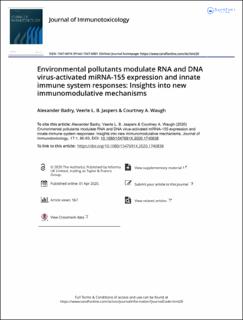| dc.contributor.author | Badry, Alexander | |
| dc.contributor.author | Jaspers, Veerle L.B. | |
| dc.contributor.author | Waugh, Courtney Alice | |
| dc.date.accessioned | 2020-07-06T14:00:26Z | |
| dc.date.available | 2020-07-06T14:00:26Z | |
| dc.date.created | 2020-04-29T12:43:42Z | |
| dc.date.issued | 2020 | |
| dc.identifier.citation | Badry, A., Jaspers, V.L.B. & Waugh, C.A. (2020). Environmental pollutants modulate RNA and DNA virus-activated miRNA-155 expression and innate immune system responses: Insights into new immunomodulative mechanisms. Journal of Immunotoxicology, 17(1), 86-93. doi: | en_US |
| dc.identifier.issn | 1547-6901 | |
| dc.identifier.uri | https://hdl.handle.net/11250/2660865 | |
| dc.description.abstract | Many persistent organic pollutants, such as polychlorinated biphenyls (PCBs), have high immunomodulating potentials. Exposure to them, in combination with virus infections, has been shown to aggravate outcomes of the infection, leading to increased viral titers and host mortality. Expression of immune-related microRNA (miR) signaling pathways (by host and/or virus) have been shown to be important in determining these outcomes; there is some evidence to suggest pollutants can cause dysregulation of miRNAs. It was thus hypothesized here that modulation of miRNAs (and associated cytokine genes) by pollutants exerts negative effects during viral infections. To test this, an in vitro study on chicken embryo fibroblasts (CEF) exposed to a PCB mixture (Aroclor 1260) and then stimulated with a synthetic RNA virus (poly(I:C)) or infected with a lymphoma-causing DNA virus (Gallid Herpes Virus 2 [GaHV-2]) was conducted. Using quantitative real-time PCR, expression patterns for mir-155, pro-inflammatory TNFα and IL-8, transcription factor NF-κB1, and anti-inflammatory IL-4 were investigated 8, 12, and 18 h after virus activation. The study showed that Aroclor1260 modulated mir-155 expression, such that a down-regulation of mir-155 in poly(I:C)-treated CEF was seen up to 12 h. Aroclor1260 exposure also increased the mRNA expression of pro-inflammatory genes after 8 h in poly(I:C)-treated cells, but levels in GaHV-2-infected cells were unaffected. In contrast to with Aroclor1260/poly(I:C), Aroclor1260/GaHV-2-infected cells displayed an increase in mir-155 levels after 12 h compared to levels seen with either individual treatment. While after 12 h expression of most evaluated genes was down-regulated (independent of treatment regimen), by 18 h, up-regulation was evident again. In conclusion, this study added evidence that mir-155 signaling represents a sensitive pathway to chemically-induced immunomodulation and indicated that PCBs can modulate highly-regulated innate immune system signaling pathways important in determining host immune response outcomes during viral infections. | en_US |
| dc.language.iso | eng | en_US |
| dc.publisher | Taylor & Francis Online | en_US |
| dc.rights | Navngivelse 4.0 Internasjonal | * |
| dc.rights.uri | http://creativecommons.org/licenses/by/4.0/deed.no | * |
| dc.title | Environmental pollutants modulate RNA and DNA virus-activated miRNA-155 expression and innate immune system responses: Insights into new immunomodulative mechanisms | en_US |
| dc.type | Peer reviewed | en_US |
| dc.type | Journal article | en_US |
| dc.description.version | publishedVersion | en_US |
| dc.rights.holder | © 2020 The Author(s) | en_US |
| dc.subject.nsi | VDP::Matematikk og Naturvitenskap: 400::Zoologiske og botaniske fag: 480::Økotoksikologi: 489 | en_US |
| dc.subject.nsi | VDP::Medisinske Fag: 700::Basale medisinske, odontologiske og veterinærmedisinske fag: 710::Toksikologi: 730 | en_US |
| dc.source.pagenumber | 86-93 | en_US |
| dc.source.volume | 17 | en_US |
| dc.source.journal | Journal of Immunotoxicology | en_US |
| dc.source.issue | 1 | en_US |
| dc.identifier.doi | 10.1080/1547691X.2020.1740838 | |
| dc.identifier.cristin | 1808650 | |

